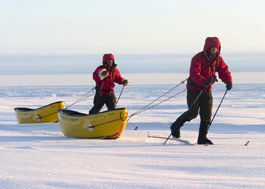
On May 12, Arctic explorers Lonnie Dupre and Eric Larsen will set off on a summer crossing of the Arctic Sea, by way of the North Pole –- a journey so difficult that no polar adventurer has ever seriously considered it.
The North Pole was first reached by Robert E. Peary almost a century ago, and every expedition there since has been undertaken during the winter months, for a simple reason: in the winter the entire crossing is made over ice and snow. In summer you’d to cross vast expanses of ice and water.
To be sure, a winter explorer has to contend with extreme conditions–primarily severe cold. Larsen and Dupre, by contrast, have to prepare for hot and cold, wet and dry, shifting ice, days and days of continuous sun, and long hours of impenetrably thick fog.
If that’s not challenge enough, Dupre and Larsen are planning to travel the roughly 1,200 mile, 100 day journey without any outside support, meaning they will bring absolutely everything they need with them, paddling or towing over 340 pounds each, the entire length of the trip.
What gives these two men the confidence they can pull this off? For one thing, both have years of experience in the Arctic. In 1989, Dupre crossed the Bering Sea with six Soviets and six Americans to promote peace between the two superpowers. Between 1997 and 2001, he circumnavigated Greenland.
It was on his four-year journey around Greenland that Dupre encountered entire cultures of people who were directly experiencing the rapid effects of global warming. The current expedition is intended, in part, to bring attention to similar effects in the Arctic. The region may be devoid of sea ice as soon as the middle of this century, animals like polar bears are on the verge of extinction, and native populations like the Inuit may be forced to abandon their ways of life.
Dupre and Larsen sat down to chat with Mother Jones on a recent visit to San Francisco.
Mother Jones: Tell us a little about the journey you have planned.
Lonnie Dupre: The name of the expedition is the “One World Expedition” and it will begin on May 12th from a place called Cape Arcitchesky off Russia’s Northern coast. We’re gonna make a 1,250 mile crossing of the Arctic Ocean by the North Pole to Canada’s Ellesmere Island. The purpose of the expedition is to bring attention to global warming.
No one’s ever even tried this in the summer before, and once we leave the Cape, we’ll have everything we need in our canoe-sled for a hundred days of travel, which is about how long we’re expecting our trip to last. The entire journey will be unsupported – we’ll be out there on our own.
MJ: What kind of preparation did this require?
LD: It’s a logistical nightmare! Any time you’re dealing with Russia and large sums of money you get quite nervous because you wonder whether or not all the permits and paperwork are really getting done.
Eric Larsen: It’s complicated because we have to get ourselves and all our gear to our starting point which means a commercial flight to Moscow, another flight to Khatanga – which is a smaller community Northern Siberia – then a 10-hour helicopter flight and then a final flight to our departure point at Cape Arcitchesky. All of this is weather dependent.
Once we launch we’re on our own. But still, you have to think, “what if we need to get rescued?” That all needs to be planned in advance as well. If we get in trouble, we have to rely on helicopters or Russian Icebreakers. If we make it past the Pole to a point where we’re out of range of the Russian helicopters, we have to rely on Canadian support, and there’ll be a period in there where a rescue would actually be impossible. These are a few of the reasons why this trip hasn’t even been attempted before. The logistics are so incredibly complicated.
MJ: So you just hope for the best I suppose…
EL: To a certain degree we’re taking a big risk, but we also need to be responsible ourselves. As modern-day explorers, we don’t want to rely on the goodwill of nation’s to rescue us. Just like somebody on a weekend hike needs to be responsible – there’s no difference. Our journey is just on a grander scale.
EL: We don’t wanna die. Our goal is to live.
MJ: Once you guys are on your own, what does the trip look like?
LD: At the heart of it, we use a strategy of skiing and canoeing. Skiing and pulling a sled is common; skiing and pulling a canoe is what makes our mission amphibious, it’s a modified version of what I developed when I traveled around Greenland. We used to drag kayaks across the ice but they don’t drag real well–they go one way or the other, they’re too long, they cross your path up. As I was going through this stuff I was thinking, “what would be the optimum boat to use on the pack ice? And it turned out to be a whitewater canoe.”
MJ: I imagine that’s the only way to do a trip like this?
LD: In the summer, yes. I mean, you go across a mile of ice and there’s gonna be water to contend with. If this is a winter expedition, we’d have had our gear planned two years ago. And if it was a completely summer expedition in the sub-Arctic, that’d be no problem either. But this is a combination of the two – and you need equipment for all sorts of conditions, wet and dry, warm and cold.
EL: There will be times that we’re coming up to leads that are so choked with ice that we can’t paddle through them and may not be not consolidated enough to ski across. So we may end up crawling across and pulling our boats or half swimming. We have these things called gaffe hooks – just a wooden pole with hooks on the end–and we’ll just gaffe our way through.
LD: It won’t always be pretty. This is a technique we used in Greenland, and it worked fairly well. With the dry-suits, in these conditions, we can actually salamander across the top of the ice chunks with a rope attached to the suit and the boat. We can just tow the boat through these conditions.
MJ: You guys are planning on sending pictures back – will we get to see the “salamander” in action?
EL: We have a nice little digital camera that’s water resistant, so we should be able to get some interesting pictures – maybe Lonnie’s face resting on an ice-block somewhere, towing the canoe behind him.
Later in the expedition we’ll probably be skiing more once we reach some more solid pack. We’ll still encounter leads where we’ll have to get in the canoes, but by that time they’ll mostly be used as sleds. It will also be the height of summer, which means more melt-water pools and mushier snow conditions. We have snowshoes we can use on pressured ice and we have some pretty heavy duty crampons, too.
LD: We’ll actually be the first expedition to use snowshoes on the Arctic Ocean since Robert Peary went up there in 1909.
MJ: What kind of food will you be bringing – we heard something about 300 Clif bars?
LD: 340 each! Actually I love Clif Bars. Other than that, everything’s a one-pot meal, and already in the bag – you just put it in boiling water and shut the stove off and let it steep for 20 minutes. You save a lot of fuel and it makes it much easier when you’re tired from too many hours of travel.
Breakfast is mainly oatmeal, but to break that monotony we have some buckwheat cereal, rice pudding, and dehydrated beans that we mix with dehydrated eggs to make huevos rancheros – or at least a version of it. We’ll wash all that down with some energy drink.
For lunch we’ll have some aged Italian salami, more Clif bars, of course, and chocolate bars, with nuts and raisins for a little more protein. For dinner we’ll have a base of rice, pasta, or potatoes. That comes out to around 6,000 calories a day. You’d be amazed how hungry you are after dragging a 300 pound sled all day long.
EL: And we’ll end up losing weight. It’s the first diet where you lose weight after eating 6,000 calories per day!
MJ: So why hasn’t this been done before? I mean, it seems people have traveled on every inch of the globe, but you say this is the first Arctic summer crossing?
LD: Explorers from Peary’s time in 1909 have been going to the North Pole. But I think people just haven’t thought out of the box. Also, an Arctic crossing requires two types of Arctic travel skills–Arctic kayaking and winter traveling.
EL: Even now we talk to a lot of the prominent polar explorers, and they still can’t seem to grasp what we’re doing because it is so unconventional. They say it’s impossible, or very unlikely.
MJ: I think people have this impression that the Arctic is this vast expanse of ice and water–which it really is–but I imagine, after all the time you both have spent up there, that you regard it as more than just some harsh, barren wilderness.
LD: Well, if you travel on the surface, the Arctic seems dead and lifeless. But if you flip an ice pan over, it’s full of algae and there are little fish that live under there. There are seals you don’t see. It’s a living ocean like any other ocean. And when we get across, the world is going to seem that much smaller. I had that feeling after traveling around Greenland, which is huge, and yet we were able to go around it. It just makes the whole world feel like a very small place, and reminds us that we need to protect these spots.
EL: The thing about the Arctic is that it’s a real subtle beauty. But it’s more than that, too, because it’s so vast–and that’s not subtle at all. You’re just this small thing in this vast space, and it’s really inspiring just to be there. And you may think looking from a position high above that it’s all the same, but traveling across at a snail’s pace you notice details like a piece of snow curved delicately. It’s a sublime beauty.
Now on the other hand when you’re having a bad day and the boat feels like a million pounds and you think, “left foot… right foot,” and all you see are your skies and boots…
MJ: You both have years of experience in the Arctic. Have you noticed the effects of global warming?
LD: Absolutely. Even growing up in Minnesota you’d have to be blind not to see the changes. We used to have substantial winters in Minnesota and massive amounts of snowfall. Now you don’t even know if you can cross-country ski in northern Minnesota in a given year.
I’ve lived and traveled with the Inuit in Alaska and Canada and the polar Eskimos of Greenland and they all have told me about changes that are happening in the Arctic. The ice is melting and undermining the foundations of many of their buildings. They’re seeing robins for the first time, and species of insects they don’t even have names for. Migration patterns of some of the animals that they hunt are changing. Ice is forming later in the winter and melting earlier in the spring, so dog-sledding becomes very dangerous. The Inuit elders used to be able to predict the weather at least three days out. Now they can’t predict the weather from one day to the next.
MJ: Doing this sort of adventure journey is a completely different way of focusing people’s attention towards global warming. Do you think it could captivate the American public in a way scientists and politicians haven’t been able to?
EL: We’re just two average guys but we’re busting our butts across all that sea ice, and I think adventure is interesting to many, many people. We’re using the expedition as a tool to communicate the dramatic changes that are happening to a worldwide audience, who hopefully will be influenced into action.
MJ: Have you linked exploration and activism in the past?
LD: During our circumnavigation of Greenland we had a website linked to 300 schools in the upper Midwest, and kids followed us along the journey and asked us questions like “Did you see any polar bears today?” That was more of a cultural and geography program to learn about the way these people lived, and what life was like in the Northern-most place in the world that people actually live in. I thought this expedition would be a good conduit to send an environmental message through.
MJ: If you were doing a summer crossing 50-60 years ago, before global warming had really kicked in, would the journey be different?
LD:You’d still need the canoes, although the major difference is that there is much more open water now.
EL: And there’s probably more surface melt water now. This will be a benefit at times, and a hindrance at times too.
LD: But in the end, it won’t be nice to see all that melting going on. That’s the bottom line.
MJ: And you’re working with scientists?
EL: Dr. Don Perovich, who is with the Army Corp of Engineers Cold Regions Environment and Engineering Laboratory, does a lot of research on Arctic sea ice and surface melt. He’s designing a measuring protocol for us to document the amount of surface water that’s on the sea ice, so we’ll be able to establish data about the size, quality, and quantity of melt-water pools that we encounter.
LD: And we’re working with Dr. Paul Mayewski from the University of Maine. We’ll be taking snow samples about every 50 miles along the way and they’ll be analyzed for particulate and heavy metal content, like mercury and lead. Eric and I aren’t scientists, but the scientists that are involved see our expedition as a really good opportunity to collect data.
MJ: I’m curious, who are your heroes?
LD: I admire a friend of mine’s son, Dan Hanson, who can’t do expeditions like this because he’s in a wheel chair. I admire his courage. That would be the worst–not being able to get out and explore.
EL: How do you follow that up? I really admire Greg LeMond. He sat down when he was a teenager and made a list of the things he wanted to do: win the Tour de France, win the world championship. And he did it! And Will Steger -– he went to the North Pole in 1986, he’s a Minnesota guy. Crossed Antarctica, and he’s lived a life of adventure. I admire that guy.
MJ: Tell us about the dynamic between you two. This trip seems like the ultimate test of teamwork and friendship.
EL: It is interesting, because Lonnie and I are pretty different people, we solve problems really differently. It was hard initially, when we didn’t know each other and weren’t able to communicate so well. Over time it’s been good because we’ve been able to balance out – one person’s strength and one person’s weakness and vice versa –- to come up with a better end result.
MJ: When are you planning to finish the crossing?
LD: We’re expecting to hit Canada on around August 21. The last possible date we want to be out there is September 5th. After that we start losing lots of light, fall storms come in, and the ice starts to refreeze. There are parts where the ice is just thick enough that you can’t paddle through it or walk on top of it.
EL: We’re going to try to make haste around the 10th of August.
LD: At around 88 degrees North on the Canadian side we’ll start to pull out all the stops.
MJ: How can people check out what you’re doing?
EL: Our website, oneworldexpedition.com, will be updated every day while we’re on the expedition. We’ll be using a satellite phone hooked up to a palm-pilot to send text and images. Projectthinice.org will also be updated with our specific daily adventures.
LD: By having these updates coming out every single day, it brings more and more people to the site. We’re hoping to get somewhere between 7 and 8 million hits per month during the expedition.
MJ: Well, we wish you guys the best of luck, and we’ll be watching.











